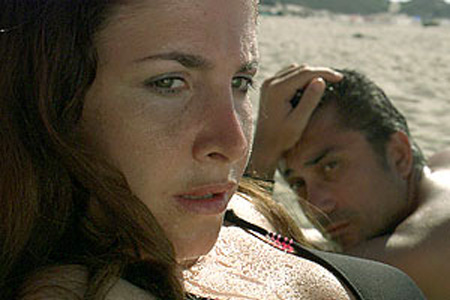Who are the greatest directors of faces in movie history? When you think of great films that could double as portrait art, there’s Carl Dreyer’s The Passion of Joan of Arc, Ingmar Bergman’s Persona, and just about any film by Federico Fellini or Robert Bresson, to name a few. Of course there are countless movies graced by memorable faces, enabled by expressive performers and highly talented cameramen and crew. But what sets the films listed above apart from the glamourous pack is a specific, individualized way of looking at a face. It’s a vision that does more than express beauty, but conveys an idea of people and how to look not just at them, but into them.
All of those aforementioned directors have passed on, so who today carries this torch? Although I’ve previously paid tribute to the unmistakable portrait art talents of Steven Spielberg, here I bring attention to the recent work of Nuri Bilge Ceylan, arguably the most accomplished filmmaker to ever emerge from Turkey. His last four films have all won prizes at the Cannes Film Festival, with the most recent, Once Upon a Time in Anatolia, sure to make many top ten lists this year. (Ceylan will be receiving Cannes Directors’ Fortnight Carrosse d’Or prize in 2012.)
Ceylan’s image-manipulating abilities come to the fore in ‘Three Monkeys:’ Note the trickle of sweat moving upwards along the son Ismail’s forehead, leading to a memory flashback of his dead brother. Shot on HD, there’s great sensitivity to the slightest nuances of expression: Watch Ismail’s face dissolve into a anguished crumple of lines upon hearing his brother call out to him.
Much has been written about his films’ masterful explorations into the dark mysteries of human behavior, set against a canvas of stunningly composed visuals. For me, the anchor point that joins together his world of shadowy emotions and precise visuals are the many gorgeous shots of human faces. This video essay assembles several of these shots into a kind of moving portrait gallery, exploring this motif through his last three films, Climates, Three Monkeys and Once Upon a Time in Anatolia (all available on Fandor). Of course the images wouldn’t be possible without the consistently stunning work of cinematographer Gökhan Tiryaki, as well as a revolving ensemble of professionals and non-professionals alike, each graced with their own distinct visage.
While I initially thought of organizing the shots around specific motifs, I decided to keep them grouped within each film to better point out the distinct visual qualities of each title. Climates, winner of the Critics’ prize for Best Picture at Cannes in 2006, is one of the greatest breakup movies in recent memory, featuring the face of Nuri Bilge Ceylan himself, matched with that of his real life wife Ebru Ceylan. As the images attest, their performances are at their most powerful without a word being said, most notably in the uninterrupted two-minute shot of Ebru Ceylan as she goes from a sun-baked smile to a slow tearful meltdown. I’ve also stitched together a shot-reverse shot sequence of the couple’s meeting in a snowfall following their breakup. Look carefully at the two shots of Ebru in the top right corner from the same scene, and you’ll notice a slight shift of position in the camera. Was the camera move intentional, meant to convey a shift in her feelings upon reuniting with her estranged lover?
In Ceylan’s next film, 2008’s Three Monkeys (which won him Best Director honors at Cannes), depicts a murderous love triangle between a chauffeur, his wife, and his boss, but the real emotional core involves the tortured circle of guilt between the married couple and their son. Here Ceylan’s image-manipulating abilities come to the fore, as the first shot in this section of the video shows: Note the trickle of sweat moving upwards along the son Ismail’s forehead, leading to a memory flashback of his dead brother. Shot on HD, there’s great sensitivity to the slightest nuances of expression: Watch Ismail’s face dissolve into a anguished crumple of lines upon hearing his brother call out to him; or mother Hacer’s face elide from consternation about her affair to a secret smile as she walks down the street.
There are more tour de force moments in Once Upon a Time in Anatolia than one can count; perhaps the most lyrical involves a girl serving tea to a police unit and two accused murderers passing through her village during a night storm. Her presence has a transformative effect on these men, illuminating them in a vision of beauty and innocence, a temporary oasis in their long night’s journey through spiritual darkness.
But another stunner occurs more gradually, creeping up on you in a way that’s become Ceylan’s trademark: A long, five-minute shot inside a police car captures four investigators making lively conversation while one murder suspect is sandwiched in the backseat. The shot crawls in on the suspect almost imperceptibly until you notice that he’s nearly full frame, haloed by the headlights behind him. I’ve juxtaposed this shot with another long shot of his victim’s wife at the moment she identifies the body; and two profile shots each for a pair of investigators. Collectively they let us see through the eyes of Ceylan, a man who seems willing to peer endlessly into the faces of people in order to reach the depths lurking within.
To watch these films is to tap into both Ceylan’s points of interest and the reserves of concentration required to pursue them, which his consummately sculpted visions make available to us. This video offers a compressed, multi-screen dose of those visions, but only as an enticement to see them in their intended form.
Kevin B. Lee is Editor in Chief of IndieWire’s PressPlay Video Blog and contributor to Roger Ebert.com. Follow him on Twitter.




